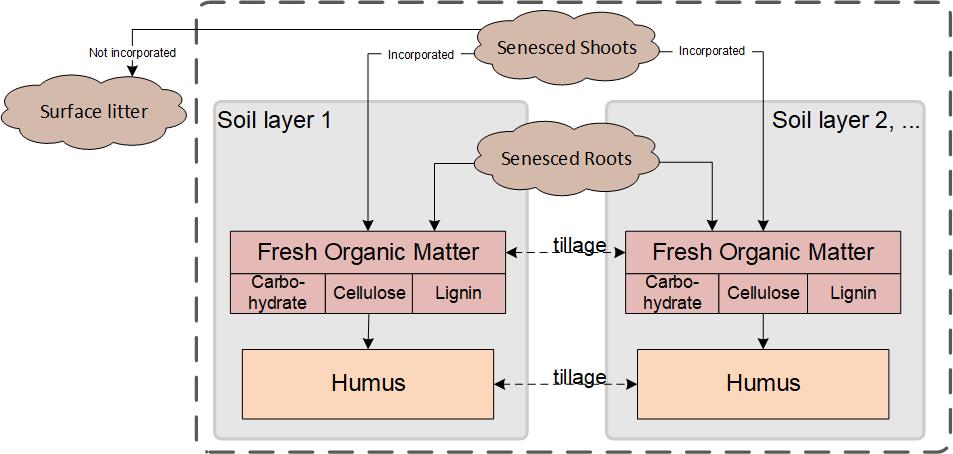
The default soil organic matter module in DSSAT is based on the original routine implemented in the CERES models (Godwin and Jones, 1991 and Godwin and Singh, 1998). The routine maintains three fresh organic matter pools and one humus pool.
Fresh organic matter decomposes based on a potential rate, and modified daily based on soil temperature, soil water content, and C:N ratios. As fresh organic matter decomposes, 20% is moved to the humus pool, with the remaining 80% of carbon lost as CO2.
The humic pool decomposition rates are computed based on a potential rate and environmental constraints (soil temperature and soil water content).
Mineralization or immobilization of N is computed based on decomposition rates, C:N ratios, and mineral N concentrations in the soil.
Organic matter can be added as management events (organic amendments), as daily increments of senesced plant matter, and as harvest residues left in the field. Properties of fresh organic matter are specified by user (for organic amendments) or obtained from file RESCHvvv.SDA (where vvv is the CSM version number).
Organic matter is lost through decomposition and can be redistributed in the soil column through tillage events. Surface organic matter is not handled explicitly by this module and is only accumulated or incorporated into the soil column with a tillage event. (Although the effects of surface organic matter are modeled by other parts of the Cropping System Model.)
References
Godwin D.C. and Jones C.A. 1991. Nitrogen dynamics in soil-plant systems. In: Modeling Plant and Soil Systems (J. Hanks and J.T. Ritchie, Eds.), p. 287-321. Agronomy monograph no. 31. ASA-CSSA-SSSA, Madison, Wi.
Godwin D.C. and Singh U. 1998 Nitrogen balance and crop response to nitrogen in upland and lowland cropping systems. In: Understanding Options for Agricultural Production (G.Y. Tsuji , G. Hoogenboom and P.K. Thornton, Eds.), p. 55-77. System Approaches for Sustainable Agricultural Development. Kluwer Academic Publishers, Dordrecht / Boston / London.
